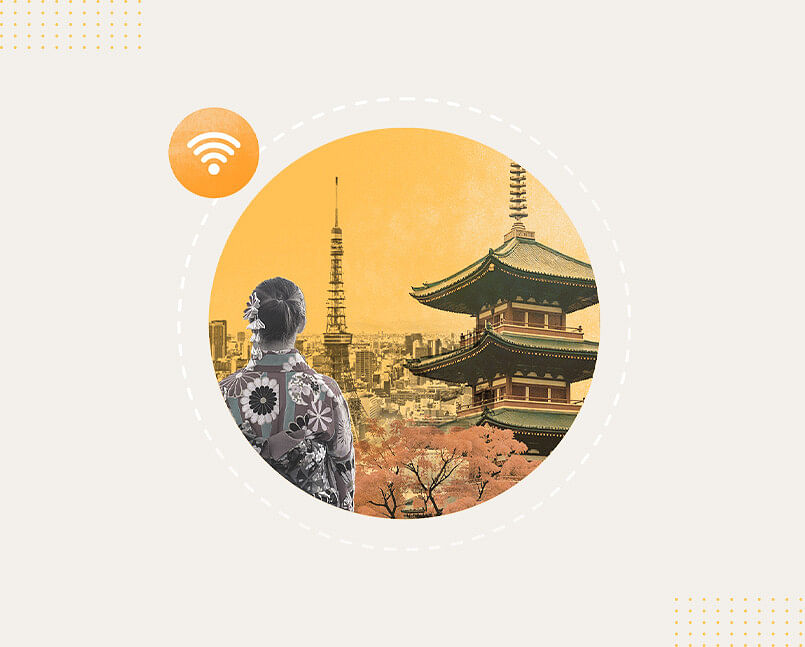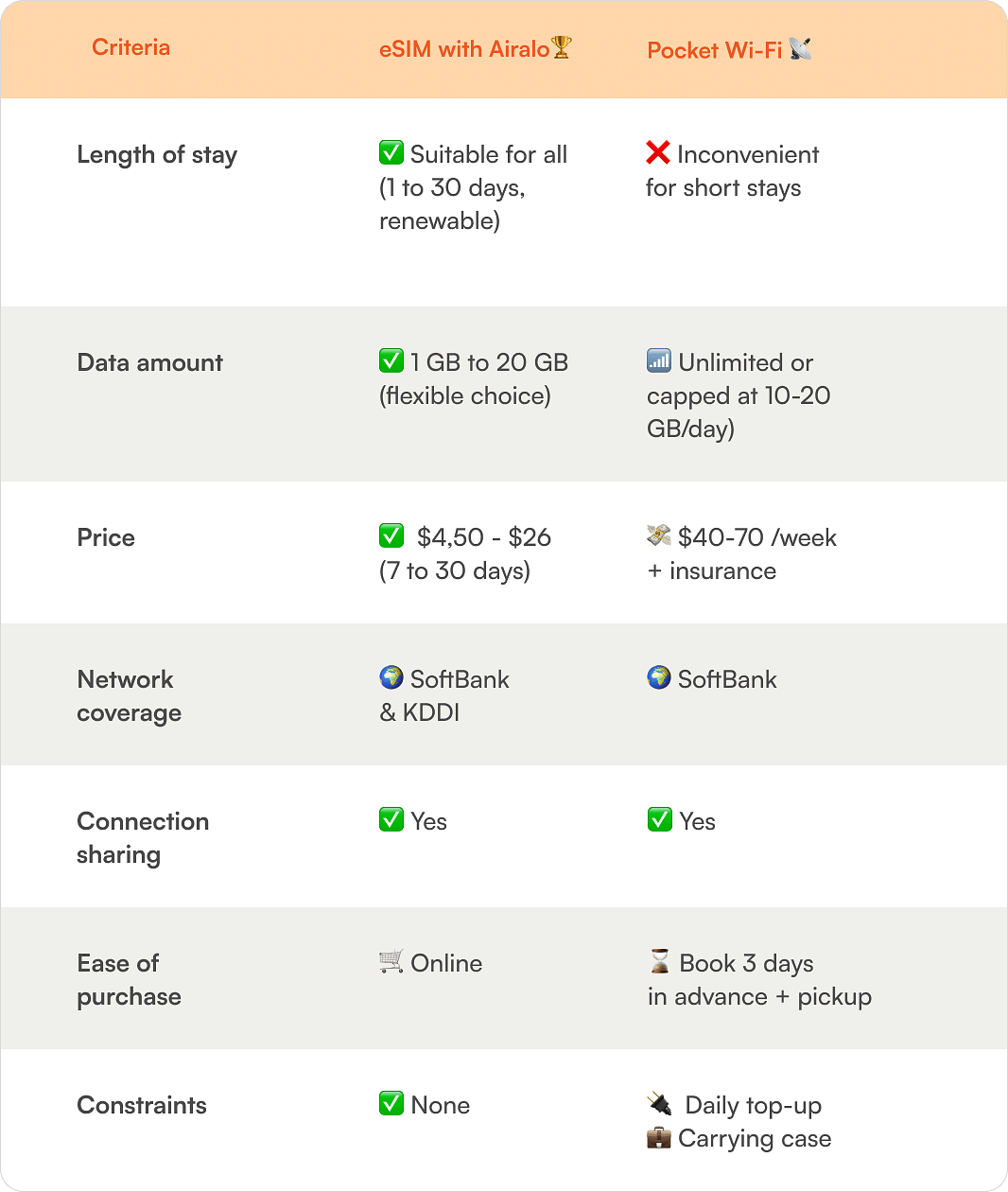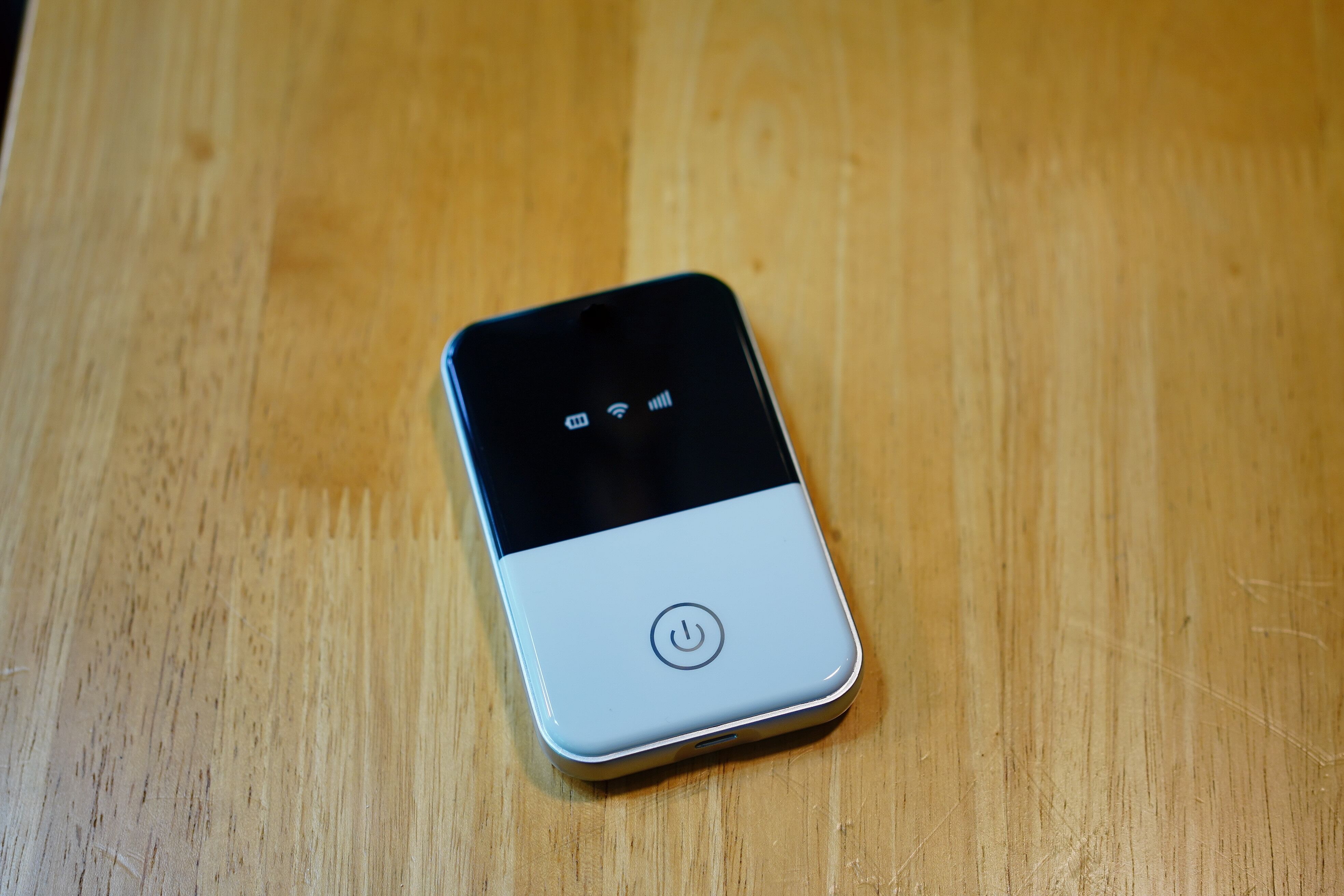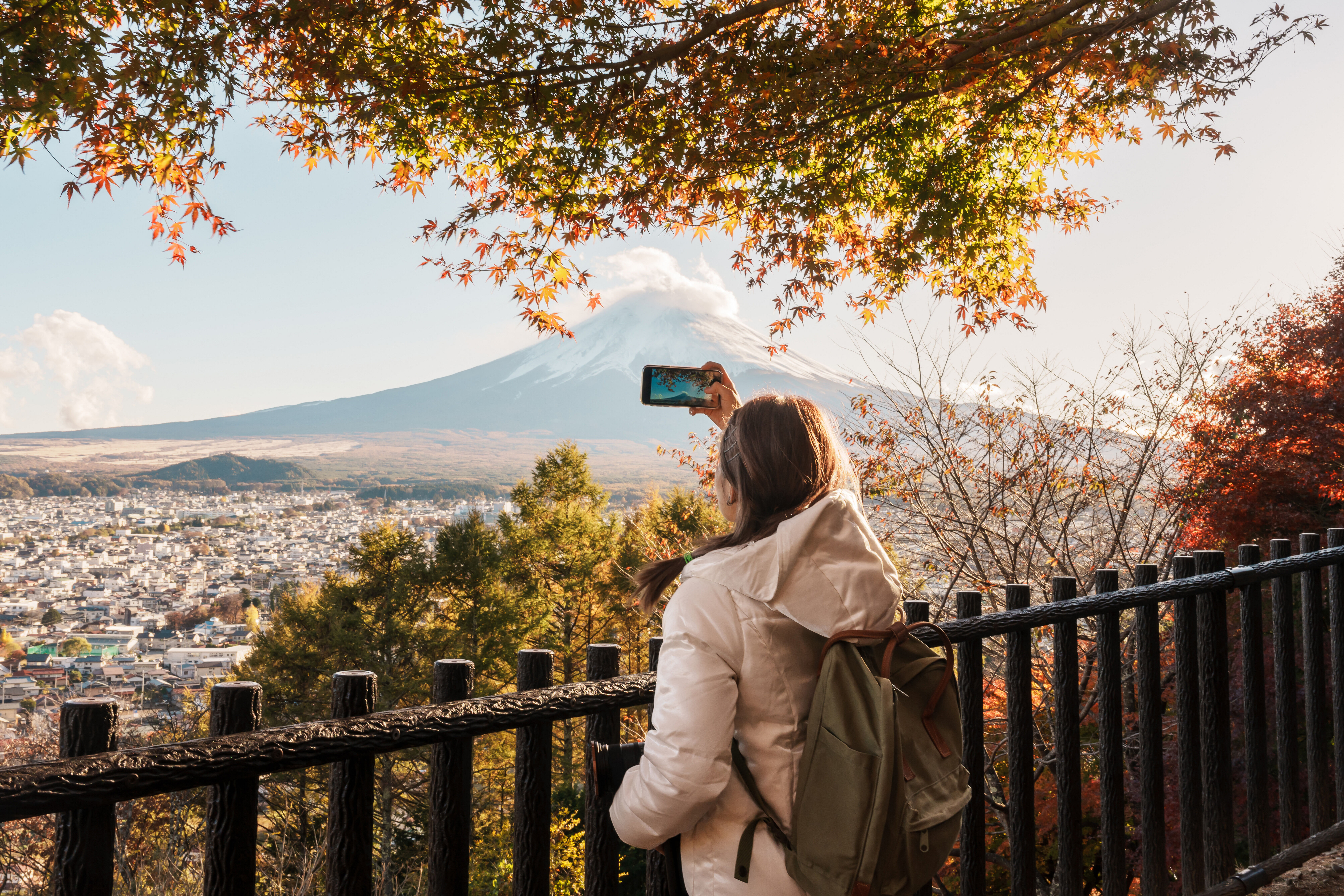
Using pocket Wi-Fi in Japan has long been the go-to option for travelers who want to stay connected. But is this still true in 2025? With the rise of eSIMs, travelers now have another option. Let's review both to decide which is right for you before your big trip!
In this article, we will cover:
- The essentials
- How does pocket Wi-Fi work in Japan?
- How much does it cost to rent a pocket Wi-Fi in Japan?
- Why is pocket Wi-Fi being replaced by eSIMs?
- What are the drawbacks of pocket Wi-Fi in Japan?
- When is pocket Wi-Fi still useful?
- How do I buy and install an eSIM for Japan?
- Related questions
The essentials
- Travel eSIMs make life easier thanks to online purchasing, quick installation, instant activation, and having nothing extra to carry.
- eSIM prices are also hard to beat: they start at $4.50 for seven days, compared with around $40 to $70 for a week's pocket Wi-Fi (excluding extra fees).
- Airalo eSIMs allow you to share your connection with other devices, making them an excellent option for remote work, families, or group trips.

How does pocket Wi-Fi work in Japan?
You'll book a small portable device that creates a private Wi-Fi network using the local mobile network. It lets you connect your phone, tablet, or laptop to the internet.
In almost all cases, travelers rent their Japan pocket Wi-Fi rather than buying it. The leading providers include:
- Japan Wireless
- Ninja Wi-Fi
- eConnect Japan
- Global Advanced Communications
Providers offer daily or weekly plans. Costs depend on data limits, duration, and speed (4G/LTE or 5G).
Conditions: If you rent a pocket Wi-Fi, you might need to pay fees in the event of damages or non-return of the device. Providers might offer insurance to reduce those fees.
Airport pick-up or delivery: Once booked, you can pick up your Japan wireless pocket Wi-Fi at the airport, have it delivered to your hotel, or have it delivered to your home before you leave. No matter your choice, you'll need to book it online and in advance.
Should you buy or rent a pocket Wi-Fi? If you decide to rent a pocket Wi-Fi, you should know it already has a built-in Japanese SIM card, ready to use as soon as you turn it on. You don't have to buy anything extra! On the other hand, if you decide to buy your own device, you'll need to invest in a SIM card and full package.
How much does it cost to rent Japan pocket Wi-Fi?
Renting a Japan wireless pocket Wi-Fi costs between $5 and $10 per day, depending on the provider, data allowance, options, and length of stay. Here are some sample rates to help you give an idea:
- Japan Wireless (Pocket Wi-Fi Premium): 7 days → $58 (includes unlimited data)
- Ninja Wi-Fi : 7 days → $63 (10 GB/day)
- eConnect Japan (Premium plan): 7 days → $40 (50 GB for 7 days)
On top of that, you'll need to pay delivery or pick-up fees - around $5 with eConnect Japan and $4 with Ninja Wi-Fi. If the device is lost or stolen and you're not insured, you'll be charged around $270 by Japan Wireless and Ninja Wi-Fi and around $70 by eConnect Japan.
 iStock
iStock
Why is pocket Wi-Fi being replaced by eSIMs?
More and more travelers are switching from pocket Wi-Fi to eSIM. Let's dive into why with a point-by-point comparison:
Length of stay 👉 eSIM wins
- eSIM: An eSIM takes just a few minutes to activate - no pick-up or return required - and you can choose a 1, 7, 15, or 30-day package depending on your needs. Find offers for all durations, even short stays!
- Pocket Wi-Fi: Even though pricing is per day, the logistics (booking, pick-up, return) are inconvenient, making it a poor choice for shorter trips.
Data Needs 👉 A personal choice
- eSIM: You can choose the data amount according to your needs, with 1 to 20 GB options.
- Pocket Wi-Fi: Options are mostly unlimited or with caps of 10 to 20 GB/day, depending on the provider. It remains an interesting option for travelers who like to stream or download.
Price 👉 eSIM wins
- eSIM: Airalo's eSIM packages for Japan cost $4.50 for 1 GB / 7 days, or $8.50 for 3 GB / 30 days, and up to $26 for 20 GB, valid for 30 days. Airalo even offers a 1 GB trial valid for 1 day free of charge! There are no hidden costs, no device to return, and no insurance to pay.
- Pocket Wi-Fi: On average, costs are between $5 and $10 per day, or $40 to $70 for a week. Add to this the cost of delivery, insurance, and risk of loss or damages. With some providers, it can be around $270 if there's an issue.
Network coverage 👉 equal
- eSIM: You'll get excellent coverage with SoftBank and KDDI national operators.
- Pocket Wi-Fi: The boxes use the best local networks, including SoftBank, so you'll also get very good coverage.
Connection sharing 👉 equal
- eSIM with Airalo: You can use your phone as a modem/hotspot to connect one or more laptops, smartphones, or tablets. Please note that this is specific to eSIM with Airalo. Not all travel eSIM providers allow connection sharing, so check before you buy.
- Pocket Wi-Fi: You can connect up to 5 to 10 devices simultaneously to Pocket Wi-Fi, including phones, tablets and laptops.
Ease of purchase 👉 eSIM wins
- eSIM: Say goodbye to lines and pick-up options. Through the Airalo app or website, you can buy and install an eSIM at home before departure and activate it in seconds upon arrival.
- Pocket Wi-Fi: You must book your device online at least 3 days in advance. You'll also need to choose a pick-up point and sometimes pay for delivery or pick it up at the airport.
Ease of use 👉 eSIM wins
- eSIM: Once installed, there's nothing else to do. No password is required; the connection activates automatically. And there's nothing to do at the end of your trip - you can delete the eSIM profile if you wish; that's it.
- Pocket Wi-Fi: You'll have to switch it on, connect, enter the Wi-Fi password, monitor the battery, and charge the travel modem every night. You'll also have to remember to return it at the end of your trip.
eSIM vs pocket Wi-Fi in Japan: the verdict
eSIMs offer everything pocket Wi-Fi does - fast speeds, device sharing, strong coverage - but without the downsides: no device to carry, no battery to charge other than your phone's, no insurance to pay, and a much lower cost! For most travelers in 2025, the real question isn't "eSIM vs. pocket Wi-Fi." It's: "Why didn't I switch to eSIM sooner?"
What are the drawbacks of pocket Wi-Fi in Japan?
- You must book Pocket Wi-Fi at least 2 to 3 days before arrival.
- Pick-up and drop-off are mandatory. In the event of loss, damage, or non-return, you'll have to pay up to $270!
- That's one more device to carry and to avoid losing.
- Battery life is limited; in most cases, you'll need to carry a power bank.
- There's also the risk of losing or having the device stolen, in which case you'll be charged extra.
- The total cost is high if you factor in delivery, insurance, and power bank costs in addition to the daily rate.
- If you forget your device or have it turned off, you can say goodbye to your internet connection.
While pocket Wi-Fi has long been a favored solution for travelers in Japan, comparing it to eSIM services highlights its downsides. The truth is with a travel eSIM, things are much easier today.
When is pocket Wi-Fi in Japan still useful?
- If your phone doesn't support eSIM technology. That said, most phones manufactured after 2018 are eSIM-compatible.
- If your phone is locked, it won't work with a local SIM or an eSIM. This is increasingly rare but still possible.
- If you're traveling with a group and need to connect multiple people heavily and consistently.
For most other scenarios, a travel eSIM is the smarter and most convenient choice.
 iStock
iStock
How do I buy and install an eSIM for Japan?
1. Purchase: Purchase it online via the Airalo website or mobile app with just a few clicks.
2. Installation: After purchase, you'll get setup instructions by email on installing the eSIM directly on your smartphone.
3. Activation: Your eSIM plan will activate automatically when you connect to a Japanese mobile network through your phone settings.

Related questions
Which SIM card do I need for pocket Wi-Fi?
When you rent a pocket Wi-Fi in Japan, a local SIM card is already installed. You don't need to do anything!
What is a Personal Wi-Fi device?
It's just another name for pocket Wi-Fi, which is also known as a mobile hotspot, mobile router, or travel Wi-Fi.
Is eSIM as reliable as pocket Wi-Fi?
Yes, and even more so! Airalo's eSIM uses the same mobile networks as pocket Wi-Fi routers. The only differences are that you'll get less hardware and that it's easier to use.
Remote work in Japan: eSIM or pocket Wi-Fi?
eSIM is the best option for digital nomads and remote workers. It enables you to share the connection from your phone to other devices, such as computers or tablets, via the "shared connection / Wi-Fi access point" feature. Travel eSIM packages are tailored to your needs, with data packs of up to 20 GB. They can also be topped up at any time. Ensure your phone is unlocked (Android | iPhone) and eSIM-compatible!
For group travel in Japan: eSIM or pocket Wi-Fi?
From a practical point of view, eSIM is easier to manage. Two options are available for groups:
- Each traveler has their own eSIM package and spends it as they wish.
- One person takes an eSIM package and shares their connection with the others. It's the most budget-friendly option for light to moderate use.
You might consider renting a pocket Wi-Fi if the whole group depends on continuous internet on several devices.
Family travel in Japan: eSIM or pocket Wi-Fi?
eSIMs are the most practical and affordable solution for families. There's no extra device to carry, and thanks to the hotspot mode, parents can share their connection with their kids.
Related Reads:
Japan Travel Guide: Everything You Need To Know
Stay Connected in Japan - Everything You Need to Know
The Best Time To Visit Japan
Choose the Best eSIM for Your Japan Trip
Airalo's Ultimate Japan Itinerary - 7 Days




